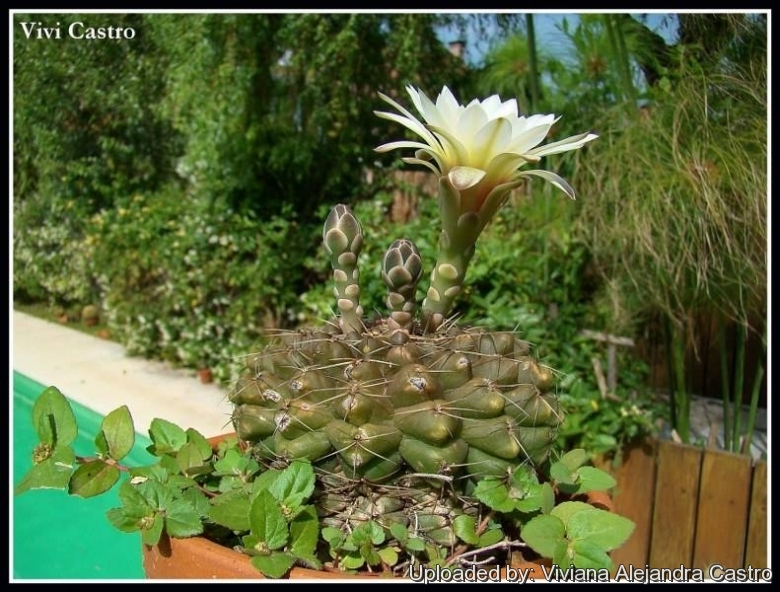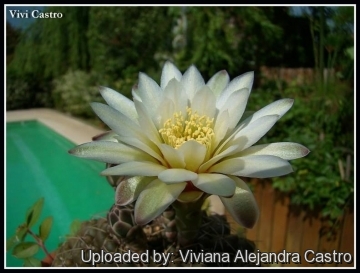Accepted Scientific Name: Gymnocalycium schroederianum Osten
Anales Mus. Nac. Montevideo II, 5(1): 60 1941

Gymnocalycium hyptiacanthum subs. schroederianum (Gymnocalycium schroederianum) Photo by: Viviana Alejandra Castro
Origin and Habitat: Gymnocalycium schroederianumSN|29277]]SN|29277]]occurs in Argentina in Buenos Aires, Corrientes, Santa Fe and Entre Ríos, and in Uruguay in Río Negro. This species is common and abundant where it occurs.
Altitude range: It occurs at elevations between 100 and 500 metres above sea level.
Habitat and Ecology: This cactus grows in low open forest on white or pinkish coloured clayey soil that frequently becomes flooded. It occurs near the tops of the range of hills by the town of Olavarría, the Sierra Bayas and other nearby Sierras in the south of Buenos Aires province. It also grows in open, flat land, at the edge of woodland, or under bushes, sometimes in grass and with moss. It grows also in frequently flooded, clayey soil. The major threat to this species may be related to habitat loss. However, because it grows in soils that are not suitable for agriculture or grazing, it is not highly impacted.
Synonyms:
Description: Gymnocalycium schroederianumSN|13933]]SN|29277]] is an attractive low growing cactus species barely rising above ground level, usually solitary in habitat, but on occasion branching basally in cultivation to form clusters. It was first discovered many years ago but was lost again so thoroughly that only Van Osten's description survived and doubts arose as to whether the mystery plant really exists. This species is different from the general run of gymnocalyciums in the colour of its flowers, in this case a pale yellowish green.
Stem: Depressed-spherical up to 7 cm tall and 14 cm across, dark grey-green.
Ribs: About 24, broad, obtuse, divided by transverse grooves in very prominent, broad tubercles.
Central spines: None.
Radial spines: Mostly 7, pale yellow at first,soon ash-grey, red at base, unequal, uppermost pair shortest, lateral pairs intermediate, lowermost spine longest, usually reaching the areole below.
Flowers: Near the apex, bell-shaped or funnelform, about 70 mm long and 55 mm in diameter at anthesis. The tube slender with conspicuous olive green, white-bordered, kidney-shaped scales. Perianth-segments pale greenish white, or yellowish-green with pale green base.
Flowering time: Blooms appear recurrently from June to autumn. It flowers quite readily as a young seedling.
Fruit: Narrowly pear-shaped, ca. 25 mm long, pale grey-green.
Seeds:* 1.2 x 1.2 mm matt black. Uruguay (Rio Negro).
Taxonomical notes: Gymnocalycium schroederianumSN|29277]]SN|29277]] is sometimes united with the little-known Gymnocalycium hyptiacanthumSN|29277]]SN|13933]].
Bibliography: Major references and further lectures
1) Edward Anderson “The Cactus family” Timber Press, Incorporated, 2001
2) David R Hunt; Nigel P Taylor; Graham Charles; International Cactaceae Systematics Group. "The New Cactus Lexicon" dh books, 2006
3) Curt Backeberg “Die Cactaceae: Handbuch der Kakteenkunde” Gustav Fischer Verlag, Stuttgart New York 1982–1985
4) James Cullen, Sabina G. Knees, H. Suzanne Cubey "The European Garden Flora Flowering Plants: A Manual for the Identification of Plants Cultivated in Europe, Both Out-of-Doors and Under Glass" Cambridge University Press, 11/Aug/2011
5) Kiesling, R., Oakley, L., Duarte, W. & Demaio, P. 2013. Gymnocalycium schroederianum. The IUCN Red List of Threatened Species. Version 2014.2. <www.iucnredlist.org>. Downloaded on 01 November 2014.
6) Checklist of CITES Species Part 1 CITES species index, 2011
7) Roberto Kiesling, Omar E. Ferrari “Cien cactus argentinos” Editorial Albatros, 2005
8) James Cullen, Sabina G. Knees, H. Suzanne Cubey “The European Garden Flora Flowering Plants: A Manual for the Identification of Plants Cultivated in Europe, Both Out-of-Doors and Under Glass” Cambridge University Press, 11/Aug/2011
 Gymnocalycium hyptiacanthum subs. schroederianum (Gymnocalycium schroederianum) Photo by: Viviana Alejandra Castro
Gymnocalycium hyptiacanthum subs. schroederianum (Gymnocalycium schroederianum) Photo by: Viviana Alejandra CastroSend a photo of this plant.The gallery now contains thousands of pictures, however it is possible to do even more. We are, of course, seeking photos of species not yet shown in the gallery but not only that, we are also looking for better pictures than those already present.
Read More... Cultivation and Propagation: Gymnocalycium schroederianumSN|29277]]SN|29277]] is an easy to grow succulent, more cold tolerant than most and less fussy regarding soil conditions.
Growth rate: It is a relatively rapidly growing and easily flowering species that will make clumps given the best conditions.
Soils: It likes very porous standard cactus mix soil.
Repotting: Use pot with good drainage.
Watering: Water regularly in summer, but do not overwater (Rot prone), keep dry in winter.
Fertilization: Feed with a high potassium fertilizer in summer.
Hardiness: Reputedly somewhat resistant to frost if kept on the dry side prior to, and during, cold weather (hardy to -12 C ° C, or less for short periods).
Exposition: Outside bright but filtered sunlight or afternoon shade, inside it needs bright light, and some direct sun. Tends to bronze in strong light, which encourages flowering and heavy spine production.
Uses: It is an excellent plant for container growing. It always looks good and stays small. It look fine in a cold greenhouse and frame or outdoor in a rockery.
Pests & diseases: It may be attractive to a variety of insects, but plants in good condition should be nearly pest-free, particularly if they are grown in a mineral potting-mix, with good exposure and ventilation. Nonetheless, there are several pests to watch for:
- Red spiders: Red spiders may be effectively rubbed up by watering the plants from above.
- Mealy bugs: Mealy bugs occasionally develop aerial into the new growth among the wool with disfiguring results, but the worst types develop underground on the roots and are invisible except by their effects.
- Sciara Flies: Sciara flies are one of the major problems for seedlings. It is a good practice to mulch your seedlings with a layer of grit, which will strongly discourage the flies.
- Scales: Scales are rarely a problem.
- Rot: Rot it is only a minor problem with cacti if the plants are watered and “aired” correctly. If they are not, fungicides won't help all that much.
Propagation: Division, direct sow after last frost. Seeds germinate in 7-14 days at 21-27° C in spring, remove gradually the glass cover as soon the plants will be well rooted (ca 1-2 weeks) and keep ventilated, no full sun for young plants! To make a cutting twist off a branch and permit it to dry out a couple of weeks, lay it on the soil and insert the stem end partially into the soil. Try to keep the cutting somewhat upright so that the roots are able to grow downward.











